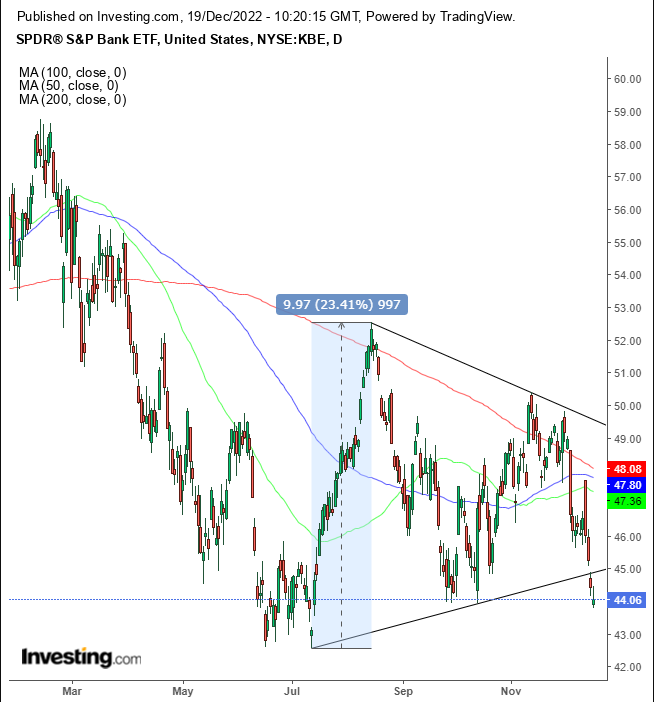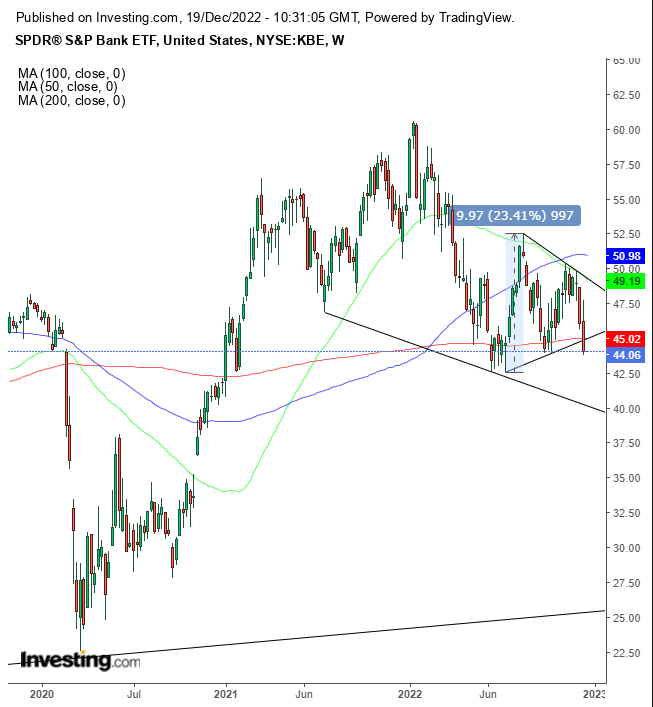- Concerns about a potential recession and weaker profit margins in the industry are hampering bank shares in the S&P 500
- The SPDR S&P Bank ETF (KBE) has completed a symmetrical triangle, indicating downward trend likely to resume
- Price has also fallen below the 200 WMA for the third time in six months, potentially completing a head and shoulders pattern
Shares of U.S. banks have been underperforming in December as investors are concerned about a potential recession and weakening profit margins in the industry. The SPDR® S&P Bank ETF (NYSE:KBE) index has declined 11% this month, while the broader S&P 500 index has dropped 5.5% over the same period. Bank of America (NYSE:BAC), Wells Fargo (NYSE:WFC), and JPMorgan Chase (NYSE:JPM) have all seen their share prices fall significantly this month.
A recession could hurt loan growth and increase credit losses for banks, while higher interest rates may shrink profit margins if the interest paid on deposits eats into the interest earned from loans. Some investors are also concerned about a potential peak in net interest margins, which measure the spread between what a bank makes on loans and fixed-income securities and what it pays out on deposits. Banks will report their fourth quarter earnings next month, which will provide more information on the state of the industry.
The SPDR S&P Bank ETF tracks the performance of the S&P Banks Select Industry Index and provides diverse exposure to stocks in the bank sector.

The bank ETF completed a Symmetrical Triangle, demonstrating the end of the give and take between buyers and sellers, keeping the price in range and that the trend is prepared to resume downward. The 100 and 50 DMA rebounded along with the price, gaining on the 200 DMA. However, the MAs have been falling away from the longest one, demonstrating resistance.
The $10 pattern height suggests a repeated move from the $45 breakout point, targeting $35.
Now, let's take a step back.

Looking at the weekly chart, we realize that the triangle is but the right shoulder of a downward-sloping H&S top. We also can see that the price fell below the 200 WMA, supporting the price since Jun.
This is the third time the price has slipped below in the past six months. Is the third time the charm? Will bears finally push the price below the mega M.A. to resume the downturn, if we are to believe the RSI? Also, this time the price completed the triangle, though lookout for a rebound as the supply-demand balance fakes out sometimes.
However, if the price does continue to fall to the $35 target, it will also complete the H&S if it has topped out. It is difficult to gauge a top whose line continually moves, but we can see how it is on the way to meeting with the uptrend line since the 2009 bottom, at around the $30 mark.
Trading Strategies: Short Position Setup
Conservative traders should wait for the price to penetrate the Jun.-Jul. lows, then execute a return move successfully retesting the triangle.
Moderate traders would sell a throwback that could follow Friday's imperfect (due to a slight lower shadow) inverted hammer.
Aggressive traders can short according to their strategies. Here is a generic example:
Trade Sample - Short
- Entry: $45
- Stop-Loss: $46
- Risk: $42
- Reward: $3
- Risk-Reward Ratio: 1:3
Disclosure: The author does not own any of the securities mentioned in this article.
